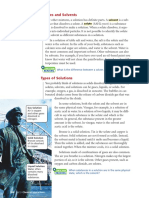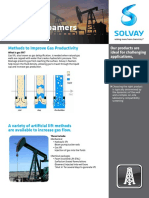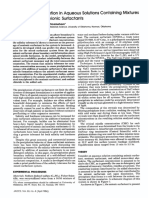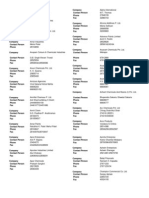Professional Documents
Culture Documents
An Energy Efficient Optimal Path Selection Using AODV Protocol in Wireless Sensor Network
Copyright
Available Formats
Share this document
Did you find this document useful?
Is this content inappropriate?
Report this DocumentCopyright:
Available Formats
An Energy Efficient Optimal Path Selection Using AODV Protocol in Wireless Sensor Network
Copyright:
Available Formats
Volume 7, Issue 6, June – 2022 International Journal of Innovative Science and Research Technology
ISSN No:-2456-2165
Oxidation of Hydroxyzine with Potassium
Permanganate: A Kinetic Study
Syed Yousuf Hussain
Department of Chemistry, Kohinoor Arts,
Commerce & Science College Khuldabad, Dist. Aurangabad 431101
Abstract:- Hydroxyzine a pharmaceutical used as recorded. The graph of absorbance versus the mole ratio is
antihistamine is oxidized with potassium permanganate plotted to know the stoichiometry of the reaction. The
to study its kinetics at various temperatures. The rate of obtained stoichiometric equation is as follows;
reaction was observed is first order with respect to
substrate and oxidant whereas it is independent on acid 10C21H27ClN2O2 + 4KMnO4 + 6H2SO4 → 10C21H27ClN2O3
medium. There is no effect of salt on the rate of reaction + 2K2SO4 + 4MnSO4 + 6H2O
and no polymerization initiated during the reaction. The
final product obtained is identified as hydroxyzine N- The reaction product is identified by reacting desired
oxide. The suitable mechanism is proposed and rate law quantity of the hydroxyzine, potassium permanganate and
is derived. sulphuric acid and kept the reaction mixture for two days for
completion of the reaction. One of the product is extracted
Keywords:- Oxidation, Mechanism, Hydroxyzine, Kinetics, with ether, the organic layer obtained was separated and
Acid. treated with sodium bicarbonate and washed with distilled
water. The ether layer was evaporated and dried to get
I. INTRODUCTION product. The product obtained is Hydroxyzine N-oxide. It is
confirmed by spot tests [4].
Antihistamines are the drugs used to treat allergic
conditions such as itches, hay fever, etc. These chemicals are III. RESULTS & DISCUSSION
used to treat excess of histamines produced in the body.
Hydroxyzine is an antihistamine working as a blocking agent A. Effect of concentration of substrate
for histamine produced excessively in the body. Present study Pseudo-first order kinetics is followed for observing the
deals with the kinetic study of oxidation of hydroxyzine and effect of different parameters on the rate of reaction. The
its mechanistic aspects. The oxidizing agent used is pseudo-first order rate constants were determined with
potassium permanganate. It is a strong oxidizing agent used various initial concentrations of the hydroxyzine whereas
for oxidation of various organic compounds in acid medium. keeping other conditions constant i.e. concentration of
The potassium permanganate is used extensively for potassium permanganate solution, concentration of sulphuric
oxidation reaction. It does not produce toxic substances after acid solution, temperature, etc. The kobs calculated from the
completion of the reaction. Potassium permanganate is used graph of logobs versus time. The rate constant is found to be
by many workers for oxidation of various organic compounds increasing with the increase in the concentration of
e.g. ciprofloxacin [1], L-tryptophan [2], naphthalene [3], etc. hydroxyzine. This can be treated as first order kinetics [5].
but no one has studied kinetic study of oxidation of
hydroxyzine with potassium permanganate. B. Effect of concentration of oxidant
The pseudo-first order rate constants were determined
II. MATERIALS & METHODS with various initial concentrations of the potassium
permanganate solution whereas keeping other conditions
All the chemicals used for the study were of analytical constant i.e. concentration of hydroxyzine solution,
grade and used without any purification. Doubly distilled concentration of sulphuric acid solution, temperature, etc.
water is used throughout the course of reactions for The result is obtained from the graph of kobs versus time. The
preparation of solutions. For kinetic study the reaction is run kobs rate constant is found to be increasing with the increase
with excess potassium permanganate solution compared to in the concentration of potassium permanganate indicating
hydroxyzine in the presence of sulphuric acid solution. The first order dependence of the rate of the reaction.
reaction is monitored spectrophtometrically by estimating
unreacted potassium permanganate with regular intervals at C. Effect of H+ concentration
540 nm. The pseudo-first order rate constants were determined
with various initial concentrations of the sulphuric acid
A. Stoichiometry solution whereas keeping other conditions constant i.e.
For stoichiometric studies solutions of different concentration of hydroxyzine solution, concentration of
concentrations of hydroxyzine and same concentration of potassium permanganate solution, temperature, etc. The
potassium permanganate and sulphuric acid were reacted and result is obtained from the graph of lobabs versus time. The
kept the reaction mixture for about five hours. After kobs rate constant does have much impact indicating rate of
completion of reaction absorbance of the solutions were the reaction is not depending on the concentration of H+.
IJISRT22JUN349 www.ijisrt.com 201
Volume 7, Issue 6, June – 2022 International Journal of Innovative Science and Research Technology
ISSN No:-2456-2165
D. Effect of temperature The overall rate is the rate of formation of HYD→O
The oxidation of hydroxyzine was carried out at
different temperatures from 303K to 323K whereas the d[HYD→O] k1 k2
concentration of the hydroxyzine, potassium permanganate Rate = --------------- = k2 [Inter] = ------[HYD] [PP]
and sulphuric acid were kept constant. The result shows the dt k-1 + k2
rate of the reaction increases with rise in temperature
indicating first order dependence on temperature. From the Since k-1 is much smaller than k2, k-1<< k2 neglecting k-
linear Arrhenius plots of logkobs versus 1/T activation 1in the above equation, rate equation is reduced to
parameters were calculated. The Arrhenius activation energy Rate = k1[HYD] [PP]
values calculated as 23.6kJ/mole. The other thermodynamic
parameters are H= -13kJ/mole & S = -32 J/Kmole and IV. CONCLUSION
_G = -1.2 kJ/mole.
The kinetics of oxidation of hydroxyzine with
E. Effect of salt potassium dichromate in acid medium was studied. The
To study the effect of salts on the rate of reaction NaCl, reaction undergoes to give an intermediate which on
KCl, KBr, MgCl2 these salts were added in the reaction decomposition in the rate determining step gives the oxidized
mixture keeping all other conditions constant at 298K product. The proposed mechanism and rate law is suggested
temperature. There is no effect of addition of salt observed on for the reaction. The reaction is found to be first order with
the rate of reaction indicating no interaction of charged respect to substrate i.e. hydroxyzine and potassium
species during the reaction. permanganate whereas it is independent on the concentration
of acid. There is no effect on the rate of reaction of addition
F. Free radical test of salt showing no interaction of charged species during the
Acrylonitrile is used to test the presence of reaction [7].
polymerization. It is added to the solution of substrate,
oxidant and acid in proper proportion. There is no initiation ACKNOWLEDGEMENT
of polymerization indicating there are no free radicals formed
during the reaction [6]. The author is thankful to Principal Kohinoor Arts,
Commerce & Science College Khuldabad, Dist Aurangabad
G. Proposed Mechanism of the reaction for giving permission to carryout research work in the
laboratory.
10C21H27ClN2O2 + 4KMnO4 + 6H2SO4 → 10C21H27ClN2O3
+ 2K2SO4 + 4MnSO4 + 6H2O REFERENCES
C21H27ClN2O2 + MnO4- + H+ → C21H27ClN2O2 –O-MnO3- [1]. Ankita Jain. (2015). Kinetics and mechanism of
H+ (1) Intermediate permanganate oxidation of ciprofloxacin in aqueous
C21H27ClN2O2 –O-MnO3-H+ → C21H27ClN2O3 + H2O + sulphuric acid medium, Int. J. Pharm. Sci. & Drug Res.
Mn+2 (2) 7 (2): 205-210.
[2]. Idongesit B. et al. (2012). Kinetics and mechanistic
The rate equation can be proposed on the basis of the results approach to the oxidation of L-tryptophan by
obtained as permanganate ion in aqueous acidic medium, Pelagia
d d Research Library,3 (6): 3401-3409.
- ---- [MnO4- ] = - ---- [Mn+2] = k2 [Inter] [3]. Anweting et al. (2012). Kinetics and mechanism of
dt dt oxidation of nicotinic acid by potassium permanganate
in aqueous acidic medium. Scholars Research Library,
k1 k2 4 (4): 1628-1635.
HYD + PP ⇆ Inter → HYD→O [4]. F. Feigl, Spot tests in organic analysis, Elsevier, New
k-1 York, NY, USA, 1957.
[5]. Joseph; Basheer K.M, Radhakrishnan Nair T.D.,
d d “Effects of substituent on the kinetics of the oxidation
- ---- [MnO4- ] = - ---- [Mn+2] = k2 [Inter] of benzyl chloride using acid dichromate, Asian J.
dt dt Chem., 2007, 19(6): 4733-4738.
[6]. Vogel, Al, Text book of practical organic chemistry,
We can apply steady state approximation to Inter Longman , London, 1967.
d[Inter] [7]. Laidler K.J. Chemical Kinetic, McGraw Hill New Hill,
- ------- = 0 = k1[HYD] [PP] - k-1 New York, USA, 1976, pp. 230
dt [Inter]– k2 [Inter] .
k1
[Inter] = ----------- [HYD] [PP]
k-1 + k2
IJISRT22JUN349 www.ijisrt.com 202
You might also like
- An Analysis on Mental Health Issues among IndividualsDocument6 pagesAn Analysis on Mental Health Issues among IndividualsInternational Journal of Innovative Science and Research TechnologyNo ratings yet
- Harnessing Open Innovation for Translating Global Languages into Indian LanuagesDocument7 pagesHarnessing Open Innovation for Translating Global Languages into Indian LanuagesInternational Journal of Innovative Science and Research TechnologyNo ratings yet
- Diabetic Retinopathy Stage Detection Using CNN and Inception V3Document9 pagesDiabetic Retinopathy Stage Detection Using CNN and Inception V3International Journal of Innovative Science and Research TechnologyNo ratings yet
- Investigating Factors Influencing Employee Absenteeism: A Case Study of Secondary Schools in MuscatDocument16 pagesInvestigating Factors Influencing Employee Absenteeism: A Case Study of Secondary Schools in MuscatInternational Journal of Innovative Science and Research TechnologyNo ratings yet
- Exploring the Molecular Docking Interactions between the Polyherbal Formulation Ibadhychooranam and Human Aldose Reductase Enzyme as a Novel Approach for Investigating its Potential Efficacy in Management of CataractDocument7 pagesExploring the Molecular Docking Interactions between the Polyherbal Formulation Ibadhychooranam and Human Aldose Reductase Enzyme as a Novel Approach for Investigating its Potential Efficacy in Management of CataractInternational Journal of Innovative Science and Research TechnologyNo ratings yet
- The Making of Object Recognition Eyeglasses for the Visually Impaired using Image AIDocument6 pagesThe Making of Object Recognition Eyeglasses for the Visually Impaired using Image AIInternational Journal of Innovative Science and Research TechnologyNo ratings yet
- The Relationship between Teacher Reflective Practice and Students Engagement in the Public Elementary SchoolDocument31 pagesThe Relationship between Teacher Reflective Practice and Students Engagement in the Public Elementary SchoolInternational Journal of Innovative Science and Research TechnologyNo ratings yet
- Dense Wavelength Division Multiplexing (DWDM) in IT Networks: A Leap Beyond Synchronous Digital Hierarchy (SDH)Document2 pagesDense Wavelength Division Multiplexing (DWDM) in IT Networks: A Leap Beyond Synchronous Digital Hierarchy (SDH)International Journal of Innovative Science and Research TechnologyNo ratings yet
- Comparatively Design and Analyze Elevated Rectangular Water Reservoir with and without Bracing for Different Stagging HeightDocument4 pagesComparatively Design and Analyze Elevated Rectangular Water Reservoir with and without Bracing for Different Stagging HeightInternational Journal of Innovative Science and Research TechnologyNo ratings yet
- The Impact of Digital Marketing Dimensions on Customer SatisfactionDocument6 pagesThe Impact of Digital Marketing Dimensions on Customer SatisfactionInternational Journal of Innovative Science and Research TechnologyNo ratings yet
- Electro-Optics Properties of Intact Cocoa Beans based on Near Infrared TechnologyDocument7 pagesElectro-Optics Properties of Intact Cocoa Beans based on Near Infrared TechnologyInternational Journal of Innovative Science and Research TechnologyNo ratings yet
- Formulation and Evaluation of Poly Herbal Body ScrubDocument6 pagesFormulation and Evaluation of Poly Herbal Body ScrubInternational Journal of Innovative Science and Research TechnologyNo ratings yet
- Advancing Healthcare Predictions: Harnessing Machine Learning for Accurate Health Index PrognosisDocument8 pagesAdvancing Healthcare Predictions: Harnessing Machine Learning for Accurate Health Index PrognosisInternational Journal of Innovative Science and Research TechnologyNo ratings yet
- The Utilization of Date Palm (Phoenix dactylifera) Leaf Fiber as a Main Component in Making an Improvised Water FilterDocument11 pagesThe Utilization of Date Palm (Phoenix dactylifera) Leaf Fiber as a Main Component in Making an Improvised Water FilterInternational Journal of Innovative Science and Research TechnologyNo ratings yet
- Cyberbullying: Legal and Ethical Implications, Challenges and Opportunities for Policy DevelopmentDocument7 pagesCyberbullying: Legal and Ethical Implications, Challenges and Opportunities for Policy DevelopmentInternational Journal of Innovative Science and Research TechnologyNo ratings yet
- Auto Encoder Driven Hybrid Pipelines for Image Deblurring using NAFNETDocument6 pagesAuto Encoder Driven Hybrid Pipelines for Image Deblurring using NAFNETInternational Journal of Innovative Science and Research TechnologyNo ratings yet
- Terracing as an Old-Style Scheme of Soil Water Preservation in Djingliya-Mandara Mountains- CameroonDocument14 pagesTerracing as an Old-Style Scheme of Soil Water Preservation in Djingliya-Mandara Mountains- CameroonInternational Journal of Innovative Science and Research TechnologyNo ratings yet
- A Survey of the Plastic Waste used in Paving BlocksDocument4 pagesA Survey of the Plastic Waste used in Paving BlocksInternational Journal of Innovative Science and Research TechnologyNo ratings yet
- Hepatic Portovenous Gas in a Young MaleDocument2 pagesHepatic Portovenous Gas in a Young MaleInternational Journal of Innovative Science and Research TechnologyNo ratings yet
- Design, Development and Evaluation of Methi-Shikakai Herbal ShampooDocument8 pagesDesign, Development and Evaluation of Methi-Shikakai Herbal ShampooInternational Journal of Innovative Science and Research Technology100% (3)
- Explorning the Role of Machine Learning in Enhancing Cloud SecurityDocument5 pagesExplorning the Role of Machine Learning in Enhancing Cloud SecurityInternational Journal of Innovative Science and Research TechnologyNo ratings yet
- A Review: Pink Eye Outbreak in IndiaDocument3 pagesA Review: Pink Eye Outbreak in IndiaInternational Journal of Innovative Science and Research TechnologyNo ratings yet
- Automatic Power Factor ControllerDocument4 pagesAutomatic Power Factor ControllerInternational Journal of Innovative Science and Research TechnologyNo ratings yet
- Review of Biomechanics in Footwear Design and Development: An Exploration of Key Concepts and InnovationsDocument5 pagesReview of Biomechanics in Footwear Design and Development: An Exploration of Key Concepts and InnovationsInternational Journal of Innovative Science and Research TechnologyNo ratings yet
- Mobile Distractions among Adolescents: Impact on Learning in the Aftermath of COVID-19 in IndiaDocument2 pagesMobile Distractions among Adolescents: Impact on Learning in the Aftermath of COVID-19 in IndiaInternational Journal of Innovative Science and Research TechnologyNo ratings yet
- Studying the Situation and Proposing Some Basic Solutions to Improve Psychological Harmony Between Managerial Staff and Students of Medical Universities in Hanoi AreaDocument5 pagesStudying the Situation and Proposing Some Basic Solutions to Improve Psychological Harmony Between Managerial Staff and Students of Medical Universities in Hanoi AreaInternational Journal of Innovative Science and Research TechnologyNo ratings yet
- Navigating Digitalization: AHP Insights for SMEs' Strategic TransformationDocument11 pagesNavigating Digitalization: AHP Insights for SMEs' Strategic TransformationInternational Journal of Innovative Science and Research TechnologyNo ratings yet
- Drug Dosage Control System Using Reinforcement LearningDocument8 pagesDrug Dosage Control System Using Reinforcement LearningInternational Journal of Innovative Science and Research TechnologyNo ratings yet
- The Effect of Time Variables as Predictors of Senior Secondary School Students' Mathematical Performance Department of Mathematics Education Freetown PolytechnicDocument7 pagesThe Effect of Time Variables as Predictors of Senior Secondary School Students' Mathematical Performance Department of Mathematics Education Freetown PolytechnicInternational Journal of Innovative Science and Research TechnologyNo ratings yet
- Formation of New Technology in Automated Highway System in Peripheral HighwayDocument6 pagesFormation of New Technology in Automated Highway System in Peripheral HighwayInternational Journal of Innovative Science and Research TechnologyNo ratings yet
- The Subtle Art of Not Giving a F*ck: A Counterintuitive Approach to Living a Good LifeFrom EverandThe Subtle Art of Not Giving a F*ck: A Counterintuitive Approach to Living a Good LifeRating: 4 out of 5 stars4/5 (5794)
- Shoe Dog: A Memoir by the Creator of NikeFrom EverandShoe Dog: A Memoir by the Creator of NikeRating: 4.5 out of 5 stars4.5/5 (537)
- The Little Book of Hygge: Danish Secrets to Happy LivingFrom EverandThe Little Book of Hygge: Danish Secrets to Happy LivingRating: 3.5 out of 5 stars3.5/5 (399)
- The Yellow House: A Memoir (2019 National Book Award Winner)From EverandThe Yellow House: A Memoir (2019 National Book Award Winner)Rating: 4 out of 5 stars4/5 (98)
- Never Split the Difference: Negotiating As If Your Life Depended On ItFrom EverandNever Split the Difference: Negotiating As If Your Life Depended On ItRating: 4.5 out of 5 stars4.5/5 (838)
- Elon Musk: Tesla, SpaceX, and the Quest for a Fantastic FutureFrom EverandElon Musk: Tesla, SpaceX, and the Quest for a Fantastic FutureRating: 4.5 out of 5 stars4.5/5 (474)
- A Heartbreaking Work Of Staggering Genius: A Memoir Based on a True StoryFrom EverandA Heartbreaking Work Of Staggering Genius: A Memoir Based on a True StoryRating: 3.5 out of 5 stars3.5/5 (231)
- Hidden Figures: The American Dream and the Untold Story of the Black Women Mathematicians Who Helped Win the Space RaceFrom EverandHidden Figures: The American Dream and the Untold Story of the Black Women Mathematicians Who Helped Win the Space RaceRating: 4 out of 5 stars4/5 (894)
- On Fire: The (Burning) Case for a Green New DealFrom EverandOn Fire: The (Burning) Case for a Green New DealRating: 4 out of 5 stars4/5 (73)
- The Hard Thing About Hard Things: Building a Business When There Are No Easy AnswersFrom EverandThe Hard Thing About Hard Things: Building a Business When There Are No Easy AnswersRating: 4.5 out of 5 stars4.5/5 (344)
- The Emperor of All Maladies: A Biography of CancerFrom EverandThe Emperor of All Maladies: A Biography of CancerRating: 4.5 out of 5 stars4.5/5 (271)
- Grit: The Power of Passion and PerseveranceFrom EverandGrit: The Power of Passion and PerseveranceRating: 4 out of 5 stars4/5 (587)
- The World Is Flat 3.0: A Brief History of the Twenty-first CenturyFrom EverandThe World Is Flat 3.0: A Brief History of the Twenty-first CenturyRating: 3.5 out of 5 stars3.5/5 (2219)
- Devil in the Grove: Thurgood Marshall, the Groveland Boys, and the Dawn of a New AmericaFrom EverandDevil in the Grove: Thurgood Marshall, the Groveland Boys, and the Dawn of a New AmericaRating: 4.5 out of 5 stars4.5/5 (266)
- Team of Rivals: The Political Genius of Abraham LincolnFrom EverandTeam of Rivals: The Political Genius of Abraham LincolnRating: 4.5 out of 5 stars4.5/5 (234)
- The Unwinding: An Inner History of the New AmericaFrom EverandThe Unwinding: An Inner History of the New AmericaRating: 4 out of 5 stars4/5 (45)
- The Gifts of Imperfection: Let Go of Who You Think You're Supposed to Be and Embrace Who You AreFrom EverandThe Gifts of Imperfection: Let Go of Who You Think You're Supposed to Be and Embrace Who You AreRating: 4 out of 5 stars4/5 (1090)
- The Sympathizer: A Novel (Pulitzer Prize for Fiction)From EverandThe Sympathizer: A Novel (Pulitzer Prize for Fiction)Rating: 4.5 out of 5 stars4.5/5 (119)
- Her Body and Other Parties: StoriesFrom EverandHer Body and Other Parties: StoriesRating: 4 out of 5 stars4/5 (821)
- Calculations of Standardized HCl and Ksp of Ca(OH)2Document6 pagesCalculations of Standardized HCl and Ksp of Ca(OH)2Jj ChuaNo ratings yet
- Proteins Denatured by Heat, ChemicalsDocument2 pagesProteins Denatured by Heat, ChemicalsAkira Poscablo PiranteNo ratings yet
- XI Chemistry Chapter Equilibrium Key ConceptsDocument10 pagesXI Chemistry Chapter Equilibrium Key ConceptsSridhar MarellaNo ratings yet
- D and F Block Elements-1Document12 pagesD and F Block Elements-1ilias1973No ratings yet
- Synthesis Paper Title: BiofuelsDocument24 pagesSynthesis Paper Title: Biofuelspati_deeps234No ratings yet
- PolymersDocument27 pagesPolymershuy.dicNo ratings yet
- Appendix 4-S KSM Project HDS Pilot PlantDocument156 pagesAppendix 4-S KSM Project HDS Pilot PlantAmandaNo ratings yet
- CBQ Carbon and Its CompoundsDocument6 pagesCBQ Carbon and Its CompoundsSairam KrishNo ratings yet
- Chapter 2.6 Aldehyde & KetoneDocument40 pagesChapter 2.6 Aldehyde & Ketone0JTINGNo ratings yet
- Solutes and Solvents ExplainedDocument1 pageSolutes and Solvents ExplainedMarjorie RedonaNo ratings yet
- Daftar SingkatanDocument2 pagesDaftar SingkatanRahma YaniNo ratings yet
- Mega General Knowledge 3Document192 pagesMega General Knowledge 3Qamar Nangraj89% (9)
- BROC Mackam Dab en v1.0Document2 pagesBROC Mackam Dab en v1.0jangri1098No ratings yet
- Cellgevity Product SheetDocument3 pagesCellgevity Product SheetVictor ManalacNo ratings yet
- Mark Scheme (Results) January 2023Document17 pagesMark Scheme (Results) January 2023Niketa TennakoonNo ratings yet
- Sal de ZeiseDocument5 pagesSal de ZeiseValeria BelénNo ratings yet
- Daftar Max - Min Obat / Barang di ApotekDocument38 pagesDaftar Max - Min Obat / Barang di ApotekMeta JuliaNo ratings yet
- Thermally Stable IrCe0.9La0.1O2 Catalyst For High - Wang2016Document17 pagesThermally Stable IrCe0.9La0.1O2 Catalyst For High - Wang2016Darya DaryaNo ratings yet
- Lub Oil For Diesel Eng 2 Nohab Wn25 Wn25df 9193911900eDocument6 pagesLub Oil For Diesel Eng 2 Nohab Wn25 Wn25df 9193911900eLIVIANo ratings yet
- Activated Alumina F220 Data SheetDocument2 pagesActivated Alumina F220 Data SheetRawlinsonNo ratings yet
- LipidsDocument3 pagesLipidsCamille GrandeNo ratings yet
- Surfactant Precipitation in Aqueous Solutions Containing MixturesDocument9 pagesSurfactant Precipitation in Aqueous Solutions Containing MixturesSanjay singhNo ratings yet
- Hydroprocessing/FCC Synergy: Number 101 Spring 2007Document38 pagesHydroprocessing/FCC Synergy: Number 101 Spring 2007Món Quà Vô GiáNo ratings yet
- Paints To CallDocument36 pagesPaints To Callsantro_brancz2862No ratings yet
- OintmentDocument12 pagesOintmentErfaneh FNNo ratings yet
- Steel For Quenching and TemperingDocument7 pagesSteel For Quenching and TemperingRamesh RamNo ratings yet
- Property Lab 3Document5 pagesProperty Lab 3Lulav BarwaryNo ratings yet
- ACS Sustainable Chemistry and Engineering Rigid Polyurethane Foams From Cardanol Synthesis, Structural Characterization, and Evaluation of Polyol and Foam PropertiesDocument11 pagesACS Sustainable Chemistry and Engineering Rigid Polyurethane Foams From Cardanol Synthesis, Structural Characterization, and Evaluation of Polyol and Foam PropertiesCarlosNo ratings yet
- Clariant Formulation GlucoTain Formulation Selection 2017 EN PDFDocument79 pagesClariant Formulation GlucoTain Formulation Selection 2017 EN PDFdairaslkfosdkjflskdj100% (2)
- 4th Grading General Chemistry 2016-2017Document1 page4th Grading General Chemistry 2016-2017Mariel VillanuevaNo ratings yet




































































































